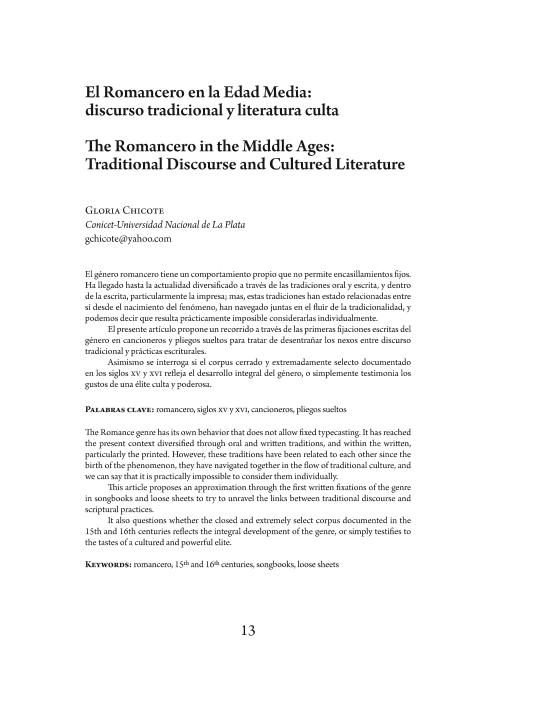Mostrar el registro sencillo del ítem
dc.contributor.author
Chicote, Gloria Beatriz

dc.date.available
2022-02-18T20:27:39Z
dc.date.issued
2018
dc.identifier.citation
Chicote, Gloria Beatriz; El romancero en la Edad Media: Discurso tradicional y literatura culta; Universidad Nacional Autónoma de México; Medievalia; 50; 2018; 13-22
dc.identifier.uri
http://hdl.handle.net/11336/152341
dc.description.abstract
El género romancero tiene un comportamiento propio que no permite encasillamientos fijos. Ha llegado hasta la actualidad diversificado a través de las tradiciones oral y escrita, y dentro de la escrita, particularmente la impresa; mas, estas tradiciones han estado relacionadas entre sí desde el nacimiento del fenómeno, han navegado juntas en el fluir de la tradicionalidad, y podemos decir que resulta prácticamente imposible considerarlas individualmente. El presente artículo propone un recorrido a través de las primeras fijaciones escritas del género en cancioneros y pliegos sueltos para tratar de desentrañar los nexos entre discurso tradicional y prácticas escriturales. Asimismo se interroga si el corpus cerrado y extremadamente selecto documentado en los siglos xv y xvi refleja el desarrollo integral del género, o simplemente testimonia los gustos de una élite culta y poderosa.
dc.description.abstract
The Romance genre has its own behavior that does not allow fixed typecasting. It has reached the present context diversified through oral and written traditions, and within the written, particularly the printed. However, these traditions have been related to each other since the birth of the phenomenon, they have navigated together in the flow of traditional culture, and we can say that it is practically impossible to consider them individually. This article proposes an approximation through the first written fixations of the genre in songbooks and loose sheets to try to unravel the links between traditional discourse and scriptural practices. It also questions whether the closed and extremely select corpus documented in the 15th and 16th centuries reflects the integral development of the genre, or simply testifies to the tastes of a cultured and powerful elite.
dc.format
application/pdf
dc.language.iso
spa
dc.publisher
Universidad Nacional Autónoma de México

dc.rights
info:eu-repo/semantics/openAccess
dc.rights.uri
https://creativecommons.org/licenses/by-nc-sa/2.5/ar/
dc.subject
ROMANCERO
dc.subject
SIGLOS XV Y XVI
dc.subject
CANCIONEROS
dc.subject
PLIEGOS SUELTOS
dc.subject.classification
Estudios Generales de Literatura

dc.subject.classification
Lengua y Literatura

dc.subject.classification
HUMANIDADES

dc.title
El romancero en la Edad Media: Discurso tradicional y literatura culta
dc.title
The romancero in the middle ages: Traditional discourse and cultured literature
dc.type
info:eu-repo/semantics/article
dc.type
info:ar-repo/semantics/artículo
dc.type
info:eu-repo/semantics/publishedVersion
dc.date.updated
2021-01-06T15:27:15Z
dc.identifier.eissn
2448-8232
dc.journal.volume
50
dc.journal.pagination
13-22
dc.journal.pais
México

dc.journal.ciudad
Ciudad de México
dc.description.fil
Fil: Chicote, Gloria Beatriz. Consejo Nacional de Investigaciones Científicas y Técnicas. Centro Científico Tecnológico Conicet - La Plata. Instituto de Investigaciones en Humanidades y Ciencias Sociales. Universidad Nacional de La Plata. Facultad de Humanidades y Ciencias de la Educación. Instituto de Investigaciones en Humanidades y Ciencias Sociales; Argentina
dc.journal.title
Medievalia
dc.relation.alternativeid
info:eu-repo/semantics/altIdentifier/url/https://revistas-filologicas.unam.mx/medievalia/index.php/mv/article/view/346
Archivos asociados
